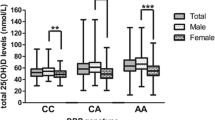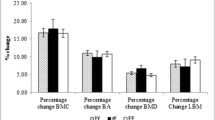Abstract
Introduction
Low bone mass after obesity surgery may arise as a consequence of chronic malabsorption of calcium and vitamin D. However, we have not found any role of serum 25-hydroxyvitamin D or of polymorphisms in the vitamin D receptor gene in previous studies.
Purpose
To investigate the circulating bioavailable 25-hydroxyvitamin D in women after bariatric procedures and its association with bone mass.
Patients and Methods
The study consisted of 91 women on follow-up for 7 ± 2 years after bariatric surgery. We measured bone mineral density (BMD), serum parathormone (PTH), 25-hydroxyvitamin D, and vitamin D binding protein (VDBP). All patients were genotyped for two variants in the coding region of VDBP (rs4588 and rs7041). Bioavailable 25-hydroxyvitamin D was calculated in double homozygotes.
Results
We found a negative correlation between bioavailable 25-hydroxyvitamin D and PTH (r = −0.373, P = 0.018), but not with BMD at lumbar spine (r = −0.065, P = 0.682) or hip (r = −0.029, P = 0.857). When adjusting by age, similar results were found for PTH (r = −0.441, P = 0.005), BMD at lumbar spine (r = −0.026, P = 0.874) and hip (r = −0.096, P = 0.561). After multivariate linear regression, forcing bioavailable 25-hydroxyvitamin D into the model resulted in a weak significant association with BMD at the lumbar spine (β = − 0.247, P = 0.025).
Conclusions
Serum bioavailable 25-hydroxyvitamin D concentrations are not associated with bone mass loss after bariatric surgery in women. The negative association with serum PTH levels suggests that vitamin D supplementation partly improves secondary hyperparathyroidism, yet other mechanisms may contribute to low bone mass after bariatric surgery.

Similar content being viewed by others
References
Finucane MM, Stevens GA, Cowan MJ, Danaei G, Lin JK, Paciorek CJ, et al. National, regional, and global trends in body-mass index since 1980: systematic analysis of health examination surveys and epidemiological studies with 960 country-years and 9.1 million participants. Lancet. 2011;377:557–67.
Berrington De Gonzalez A, Hartge P, Cerhan JR, Flint AJ, Hannan L, MacInnis RJ, et al. Body-mass index and mortality among 1.46 million white adults. N Engl J Med. 2010;363:2211–9.
Buchwald H, Oien DM. Metabolic/bariatric surgery worldwide 2011. Obes Surg. 2013;23:427–36.
Mechanick JI, Youdim A, Jones DB, Garvey WT, Hurley DL, McMahon MM, et al. Clinical practice guidelines for the perioperative nutritional, metabolic, and nonsurgical support of the bariatric surgery patient—2013 update: cosponsored by American Association of Clinical Endocrinologists, The Obesity Society, and American Society for Metabolic & Bariatric Surgery. Obesity (Silver Spring). 2013;21 Suppl 1:S1–S27.
Yip S, Plank LD, Murphy R. Gastric bypass and sleeve gastrectomy for type 2 diabetes: a systematic review and meta-analysis of outcomes. Obes Surg. 2013;23:1994–2003.
Escobar-Morreale HF, Botella-Carretero JI, Alvarez-Blasco F, Sancho J, San Millan JL. The polycystic ovary syndrome associated with morbid obesity may resolve after weight loss induced by bariatric surgery. J Clin Endocrinol Metab. 2005;90:6364–9.
Botella-Carretero JI, Balsa JA, Gomez-Martin JM, Peromingo R, Huerta L, Carrasco M, et al. Circulating free testosterone in obese men after bariatric surgery increases in parallel with insulin sensitivity. J Endocrinol Invest. 2013;36:227–32.
Balsa JA, Botella-Carretero JI, Peromingo R, Zamarron I, Arrieta F, Munoz-Malo T, et al. Role of calcium malabsorption in the development of secondary hyperparathyroidism after biliopancreatic diversion. J Endocrinol Invest. 2008;31:845–50.
Balsa JA, Botella-Carretero JI, Peromingo R, Caballero C, Munoz-Malo T, Villafruela JJ, et al. Chronic increase of bone turnover markers after biliopancreatic diversion is related to secondary hyperparathyroidism and weight loss. Relation with bone mineral density. Obes Surg. 2010;20:468–73.
Balsa JA, Botella-Carretero JI, Gomez-Martin JM, Peromingo R, Arrieta F, Santiuste C, et al. Copper and zinc serum levels after derivative bariatric surgery: differences between Roux-en-Y Gastric bypass and biliopancreatic diversion. Obes Surg. 2011;21:744–50.
Coates PS, Fernstrom JD, Fernstrom MH, Schauer PR, Greenspan SL. Gastric bypass surgery for morbid obesity leads to an increase in bone turnover and a decrease in bone mass. J Clin Endocrinol Metab. 2004;89:1061–5.
Fleischer J, Stein EM, Bessler M, Della Badia M, Restuccia N, Olivero-Rivera L, et al. The decline in hip bone density after gastric bypass surgery is associated with extent of weight loss. J Clin Endocrinol Metab. 2008;93:3735–40.
Moreiro J, Ruiz O, Perez G, Salinas R, Urgeles JR, Riesco M, et al. Parathyroid hormone and bone marker levels in patients with morbid obesity before and after biliopancreatic diversion. Obes Surg. 2007;17:348–54.
Balsa JA, Iglesias B, Peromingo R, Conde S, Vazquez C, San-Millan JL, et al. Vitamin D receptor polymorphisms in secondary hyperparathyroidism after Scopinaro’s biliopancreatic diversion. Obes Surg. 2010;20:1415–21.
Chun RF, Peercy BE, Orwoll ES, Nielson CM, Adams JS, Hewison M. Vitamin D and DBP: the free hormone hypothesis revisited. J Steroid Biochem Mol Biol. 2014;144:132–7.
Powe CE, Ricciardi C, Berg AH, Erdenesanaa D, Collerone G, Ankers E, et al. Vitamin D-binding protein modifies the vitamin D-bone mineral density relationship. J Bone Miner Res. 2011;26:1609–16.
Powe CE, Evans MK, Wenger J, Zonderman AB, Berg AH, Nalls M, et al. Vitamin D-binding protein and vitamin D status of black Americans and white Americans. N Engl J Med. 2013;369:1991–2000.
Arnaud J, Constans J. Affinity differences for vitamin D metabolites associated with the genetic isoforms of the human serum carrier protein (DBP). Hum Genet. 1993;92:183–8.
Blanton D, Han Z, Bierschenk L, Linga-Reddy MV, Wang H, Clare-Salzler M, et al. Reduced serum vitamin D-binding protein levels are associated with type 1 diabetes. Diabetes. 2011;60:2566–70.
Lauridsen AL, Vestergaard P, Hermann AP, Moller HJ, Mosekilde L, Nexo E. Female premenopausal fracture risk is associated with gc phenotype. J Bone Miner Res. 2004;19:875–81.
Cosman F, de Beur SJ, LeBoff MS, Lewiecki EM, Tanner B, Randall S, et al. Clinician’s guide to prevention and treatment of osteoporosis. Osteoporos Int. 2014;25:2359–81.
Ybarra J, Sanchez-Hernandez J, Gich I, De Leiva A, Rius X, Rodriguez-Espinosa J, et al. Unchanged hypovitaminosis D and secondary hyperparathyroidism in morbid obesity after bariatric surgery. Obes Surg. 2005;15:330–5.
Johnson JM, Maher JW, DeMaria EJ, Downs RW, Wolfe LG, Kellum JM. The long-term effects of gastric bypass on vitamin D metabolism. Ann Surg. 2006;243:701–4.
Bhan I, Powe CE, Berg AH, Ankers E, Wenger JB, Karumanchi SA, et al. Bioavailable vitamin D is more tightly linked to mineral metabolism than total vitamin D in incident hemodialysis patients. Kidney Int. 2012;82:84–9.
Schwartz JB, Lai J, Lizaola B, Kane L, Markova S, Weyland P, et al. A comparison of measured and calculated free 25(OH) vitamin D levels in clinical populations. J Clin Endocrinol Metab. 2014;99:1631–7.
Ponda MP, McGee D, Breslow JL. Vitamin D-binding protein levels do not influence the effect of vitamin D repletion on serum PTH and calcium: data from a randomized, controlled trial. J Clin Endocrinol Metab. 2014;99:2494–9.
Glendenning P, Chew GT, Inderjeeth CA, Taranto M, Fraser WD. Calculated free and bioavailable vitamin D metabolite concentrations in vitamin D-deficient hip fracture patients after supplementation with cholecalciferol and ergocalciferol. Bone. 2013;56:271–5.
Acknowledgments
We thank the nurse staff of the Department of Endocrinology and Nutrition for their help with the anthropometric and blood sampling of the patients. This work was supported in part by the Fundación para la Investigación Biomédica del Hospital Universitario Ramón y Cajal (FIBio-HRC 119/08), and Fondo de Investigación Sanitaria (FIS PI1100357), Instituto de Salud Carlos III, Spanish Ministry of Economy and Competitiveness. This study is supported in part by Fondo Europeo de Desarrollo Regional FEDER, European Union.
Author information
Authors and Affiliations
Corresponding author
Ethics declarations
Conflict of Interest
The Authors declare that they have no conflict of interest.
Ethical and Consent Statements
The study was approved by the Ethics Committee of the Hospital Universitario Ramón y Cajal, and informed consent was obtained from all individual participants included in the study.
Rights and permissions
About this article
Cite this article
Botella-Carretero, J.I., Lafuente, C., Montes-Nieto, R. et al. Serum Bioavailable Vitamin D Concentrations and Bone Mineral Density in Women After Obesity Surgery. OBES SURG 26, 2732–2737 (2016). https://doi.org/10.1007/s11695-016-2185-1
Published:
Issue Date:
DOI: https://doi.org/10.1007/s11695-016-2185-1




